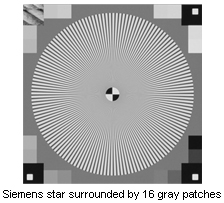
The SFRplus and eSFR ISO modules performs identical slanted-edge calculations using special test charts that enable automatic region selection and offer numerous advantages. These instructions also apply to the Rescharts Slanted-edge SFR module, which is performs identical calculations with a more interactive interface. A standardized sharpening algorithm can be used to compare cameras with different amounts of sharpening ( not recommended for camera development or lens testing). Imatest SFR also measures Chromatic aberration and noise. New ISO 12233:2014 test chart (right – supported with a high degree of automation in eSFR ISO) Old ISO 12233:2000 test chart (left) with Imatest SFR cropping indicated by the red rectangle

Imatest SFR measures spatial frequency response, also known as the Modulation Transfer Function (MTF), of digital cameras using a slanted-edge (light-to-dark) target, as described in Sharpness: What is it and how is it measured? Although it doesn’t provide the as strong a visual indication of MTF as wedge or sinusoidal chats (such as Log Frequency), it provides a more accurate quantitative measurement and uses space much more efficiently.

Setting up and photographing SFR test charts


 0 kommentar(er)
0 kommentar(er)
